Our feet are made up of bones, tendons, nerves, ligaments, and muscles that enable it to work properly, walking, standing, and other everyday movements. These parts carry our entire body weight all day long, so it’s relatively common in having foot pain. If something goes wrong with just one of these tiny parts, it can throw your entire life out of whack. Sometimes, we’ll feel top of the foot pain and swelling that can be uncomfortable when walking and even standing still. This pain will be mild to severe, depending on the cause of injury.
Foot pain makes simple tasks more challenging or even impossible. Many health conditions and injuries can upset the foot’s movement and balance, causing problems and pain. Any part of our foot can become painful for several reasons. Most foot pain requires rest and extra care to heal. If the pain is for an underlying health condition, it may need additional medical care. Here we focus on pain on top of foot causes and potential treatments.
Anatomy of the Foot
The foot is one of the complex parts of our body. It comprises 28 (Talus, Calcaneus, 5-Tarsals, 5- Metatarsals, 14 -Phalanges, 2 -Sesamoids) bones connected by 30 joints, 100 muscles, tendons, and ligaments all of which work simultaneously to provide support, balance, and mobility.

Causes of Top of the Foot Pain and Swelling
Most common of which are for overuse in activities like running, jumping, or kicking can cause pain on the top of the foot. You will require knowing the exact location of pain on the foot and the type of pain you have. This will help the doctor determine the cause of the pain and help direct him in the best treatment possible for the patient.
There are many situations you can injure your foot, from dropping something on it to turning it in the wrong way to simple overuse. Sometimes you might injure yourself and not realize it until later when symptoms manifest. Other times, such as when you have a sprain, a fracture, or a broken bone, you’ll notice right away. If the injury isn’t serious, your foot will probably heal on its own.
Sudden onset pain without the incidence of trauma on the top of the foot just behind the toes may be a stress fracture of the metatarsal bone. There is usually top of the foot swollen and painful to the touch. Conditions caused by overuse include:
Extensor Tendonitis
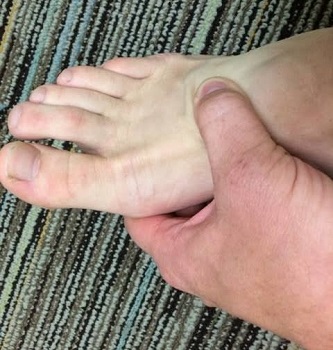
Inflammation of the extensor tendons on the top of the foot lifts the toes which will induce top-of-foot pain. This is caused by overuse or tight-fitting shoes, flat feet, prolonged standing/walking, muscle tightness, and off-road running. The tendons that run along the top of the foot and pull the foot upwards become inflamed and painful.
Symptoms of extensor tendonitis are a gradual increase in pain, swelling & tenderness on top of the foot. Discomfort enhances by wearing shoes.
Additional Resources:
- Best Shoes For Plantar Fasciitis As Per User Reviews
- Most Comfortable Steel Toe Boots For Standing All Day
Tibialis Anterior Tendonitis
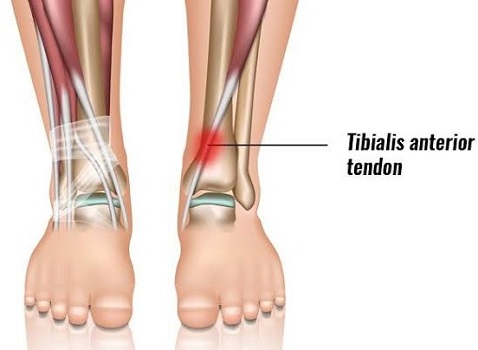
Inflammation of the tendon at the front of the ankle that lifts the foot will enhance top foot pain. Overuse, muscle weakness & tightness are the main cause, but there are factors which can increase the chance of incurring tibialis anterior tendonitis. Running up and down hills means that the tibialis anterior muscle has to work harder. When riding up a hill, the muscle lifts the foot higher than normal.
Symptoms of tibialis anterior tendonitis are a gradual increase in pain on top of the foot and ankle and worse after rest.
Sinus Tarsi Syndrome
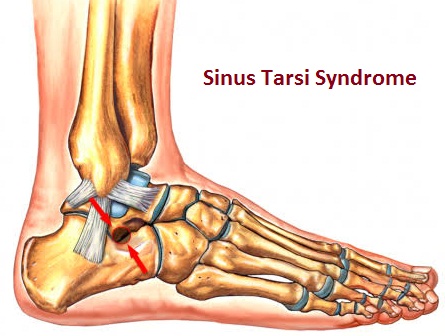
The sinus tarsi is a tunnel between the talus and the calcaneus bones. Sinus tarsi syndrome is pain or trauma to this area. This is rare and characterized as an inflamed sinus tarsus that causes pain at the top of the foot and outside the ankle. Traumatic injury to the ankle/foot (ankle sprain) or overuse is the main cause of this syndrome. It may also occur if the person has pes planus or an over-pronated foot, which can cause compression in the sinus tarsi.
Some characteristics are pain in the anterior lateral side of the ankle and the feeling of instability or pain on top of the foot from walking on unstable surfaces.
Stress Fractures on the Feet Bones
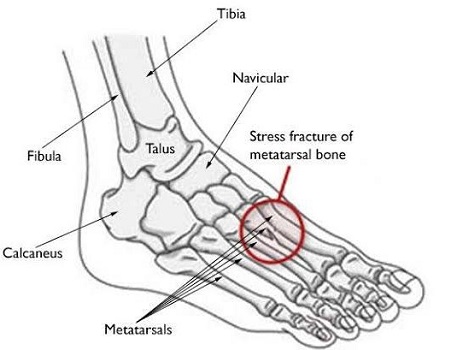
A stress fracture is a small break or severe bruising within a bone. Most stress fractures are by overuse and repetitive activity and are common in runners and athletes who participate in running sports, such as soccer, jumping, and basketball.
Symptoms of stress fractures are sharp pain on top of the foot when walking, top of the foot swollen, and tenderness over the fracture area on the top of the foot. Other causes of pain on the top of the foot can comprise:
Gout on the Foot

A type of inflammatory arthritis induces by purine-rich diet, hereditary, obesity and often linked with diabetes causes crystals formation in joints, particularly in the big toe, because of high uric acid levels. Gout symptoms are sudden onset of intense pain, redness, swelling, and heat in the joint at the base of the big toe.
Bone Spurs
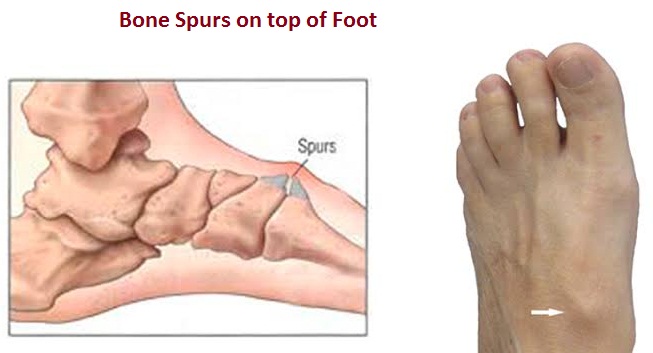
A bone spur is a painful bump on the top of the foot, which is a bony enlargement. This bump is common where the first toe joint meets the mid-foot.
This bump grows in response to friction or pressure from an imbalance. It often becomes irritated and pain on top of the foot from walking. Also, it may create a soft tissue bursa (a sac of fluid) or a Ganglion cyst. This can further induce arthritis, which usually results from the friction and wear and tear of the joint.
Hammer, Claw & Mallet Toe
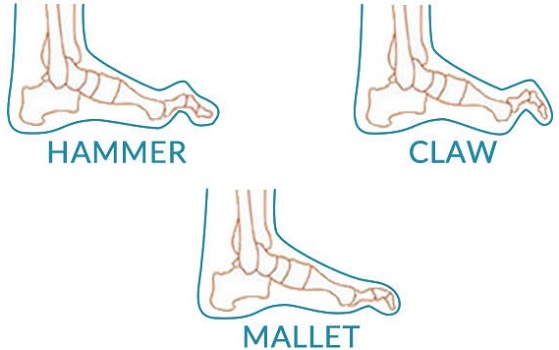
Hammer, claw, and mallet toes are toes that are bent into an odd position. These may look awkward or may hurt, or both. These toe issues almost always take place in the four smaller toes, not the big toe. A hammertoe leans down toward the floor at the middle toe joint.
A hammertoe is a toe that has an abnormal bend in its middle joint, making the toe bends downward to look like a hammer. It is the most common deformity of the second, third, or fourth toe. It is usually caused by wearing tight shoes with little to no arch support.
Claw toe generally involves the four smaller toes at the same time. The toes curl up at the joint where the toes and the foot meet. They crouch down at the middle joints and the joints nearest the tip of the toes. This leads to the toes to curl down toward the floor.
A mallet toe crouches down at the joint closest to the tip of the toe. It usually affects the second toe, but it can happen in the other toes too.
Tight, pointed shoes, toe injury, arthritis, and problems in nerves or blood vessels can enhance hammer, claw, bunion, and mallet toes. This painful condition forms by an imbalance in the surrounding muscles, tendons, or ligaments that normally keep the toe straight.
Nerve Pain

Peripheral neuropathy occurs for pinching or compression of a nerve in the foot, leg or the lower back can cause pain, prickling, or numbness that can spread up from the feet into the legs.
Common peroneal nerve dysfunction is the dysfunction of a branch of the sciatic nerve that can cause tingling and pain at the top of the foot, along with weakness of the foot or lower leg.
Symptoms of nerve pain are bruising top of the foot or shooting pain, pins, and needles, numbness and foot weakness. Swelling, injury, spinal deformity, and disc bulge can cause nerve pain.
Ganglion Cyst
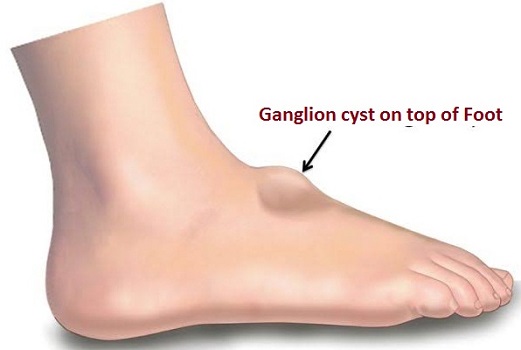
A ganglion cyst is a small sac of fluid that develops over a joint or tendon. Inside the cyst, there is a thick, sticky, colorless and jellylike material. Depending on the volume, cysts may seem firm or spongy.
Symptoms of a ganglion cyst are small, pea-like nodules. It causes pain if presses on nearby structures such as a nerve. A foot injury can cause a ganglion cyst, aging, and often unknown origin can induce this condition.
Athlete’s Foot

Athlete’s foot is the fungal infection of the feet. It commonly occurs between the toes. The athlete’s foot looks like dry, flaky, scaly skin. Symptoms often include burning, itchy feet, flaking skin, swelling, and blistering.
The athlete’s foot can cause poor foot hygiene, excess moisture, humid conditions, and contagious conditions.
Tarsal Coalition
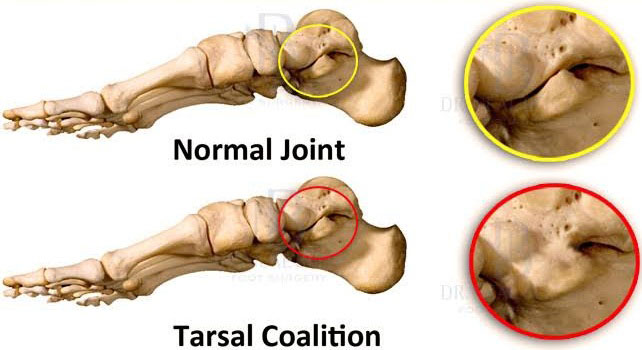
The bony bridge connects two or more of the foot bones. Symptoms of a tarsal coalition are stiffness, instability, and foot pain, commonly in early adolescence.
It is caused by congenital conditions and often hereditary.
Symptoms Top of the Foot Pain & Swelling
Pain on top of the foot is commonly followed by other manifestations which can help you work out what is wrong:
- Gradual Onset Mild-Moderate Pain: Extensor tendonitis (pain on top of the foot), tibialis anterior tendonitis (front of the ankle pain)
- Severe, Sudden Pain: Stress fracture
- Stiffness and Instability: Sinus tarsi syndrome (after an ankle sprain), tarsal coalition (early adolescence)
- Worse with activity: stress fracture, sinus tarsi syndrome
- Worse after Rest: tendonitis
- Abnormal Toe Curling: Hammer, mallet or claw toe
- Big Toe Redness: Gout
- Lump: Ganglion, stress fracture
- Itchy, Swelling, Flaking Skin: Athlete’s foot
- Pins and Needles or Numbness: Nerve issues
How Top of the Foot Pain and Swelling Diagnosed?
If you have continual foot pain that lasts lengthier than a week despite the home approach, make an appointment to see your physician.
When you make a consultation with your physician, they’ll ask you about any other symptoms and potential ways it could have injured your foot. They may seek about your physical activity and any past damages to your feet or ankle. Your physician will then review your foot. They may press on various areas on the foot to see where you feel pain.
Then, they will review your foot for any symptoms of swelling or deformity. They will study at you walking and then review at the movement and strength in and evaluate the range of motion.
To check for extensor tendonitis, your physician will ask you to flex your foot downwards, and then try to pull your toes up while they resist. If you feel pain, extensor tendonitis is possible the origin of top of the foot pain.
If your physician assumes a broken bone, fracture, or bone spurs, they’ll conduct an X-ray of the foot.
Other tests your physician may run comprise:
- Blood tests, which can analyze conditions such as gout
- An MRI for damage to the peroneal nerve
Treating Top of the Foot Pain and Swelling
The remedy for pain on top of the foot will depend on the underlying cause. If it is a minor problem with minimal pain and swelling, you can usually treat yourself at home with RICE Protocol, Non-Steroidal-Anti-inflammatory Drugs, and gentle exercises.
If the pain is more extreme, is becoming worse, there is marked swelling or you cannot bear weight, see your physician. Because our feet hold our entire body weight, a mild injury could develop into a more extensive one if it goes untreated. Treatment depends on determining the cause of the condition and may comprise:
- Physical therapy, which can help treat conditions such as peripheral neuropathy, extensor tendonitis, and damage to the peroneal nerve
- A cast or walking boot for injuries such as broken bones or fractures
- Orthotics
- NSAIDs or other anti-inflammatory drugs, which can help reduce inflammation, including inflammation from gout
- Surgery is very rare case.
- Home treatment
Home treatment can help with foot pain at most times. It would help if you rest the affected foot as much as possible. You can apply ice to the affected area in the acute phase for twenty minutes at a time or as you tolerate. Also, you may apply alternate cold & hot therapy wrap after 72 hours of injury and 3 times a day. When you have to walk, put on supportive, smooth-fitting shoes that aren’t too tight.
